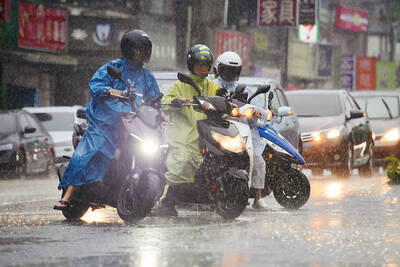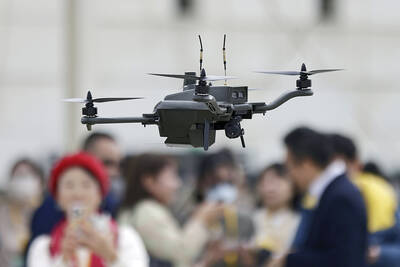The US dollar and yen firmed as the euro came under pressure on Friday with investors seeking a safe haven from the growing financial market storm.
The euro at 9pm GMT was at US$1.3394 against US$1.3590 late on Thursday in New York.
The US dollar was meanwhile trading at ¥100.51 after ¥99.50 on Thursday.
With stock markets collapsing around the world, as frightened investors bail out of equities in the midst of the worst financial crisis since the Great Depression, the dollar is seen as a refuge against chaos.
“It is difficult for anyone to miss the massive wave of risk aversion that has washed over the global markets these past two weeks,” John Kicklighter at Forex Capital Management said.
“With basic lending and borrowing [the lifeblood of the financial system] frozen by oppressively high rates, the markets are being held hostage by sentiment; and until pessimism eases, the risk-related assets will maintain their bearish trajectories,” he said.
European share prices fell hard on Friday, in line with big losses on Wall Street, which reassuring remarks from US President George W. Bush were unable to prevent.
Bush in an eight-minute speech sought to break a cycle of “uncertainty and fear” he blamed for aggravating the global financial meltdown, insisting US authorities can and will end the crisis.
In late New York trading, the dollar stood at 1.1376 Swiss francs from SF1.1289 on Thursday.
The pound was at US$1.7051 after US$1.7080.
India’s rupee tumbled to a record, leading declines in Asian currencies this week as investors pulled money from stock markets amid concern a deepening credit-market crisis will push the global economy into a recession.
The rupee dropped by the most against the greenback in more than 15 years as the Reserve Bank of India cut the cash reserve ratio for the second time in week amid a surge in lending costs between banks.
The Singapore dollar reached a one-year low after the city-state became the first economy in Asia to slip into a recession. Indonesia’s rupiah had the worst week since May 2006 after authorities shut the stock market for three days.
The rupee traded at 48.385 per dollar in Mumbai, data compiled by Bloomberg show. The currency fell as much as 4.4 percent from a week ago to an all-time low of 49.26, the biggest loss since March 1993.
The Singapore dollar dropped 2 percent to S$1.4797 and the rupiah fell 4.4 percent to 9,860.
Eight of Asia’s 10 most-active currencies outside of Japan posted weekly declines.
South Korea’s won had its biggest jump since March 1998 on Friday after a meeting among financial regulators prompted speculation that the government will step up support for the currency.
The won rose 5.4 percent to 1,309 versus the US dollar, paring this week’s decline to 6.5 percent, Seoul Money Brokerage Services Ltd said. The currency climbed as high as 1,225, after earlier dropping as low as 1,460.
Malaysia’s ringgit fell 1.2 percent this week to 3.5125 per US dollar and touched a one-year low of 3.5171.
The New Taiwan dollar declined 0.8 percent this week to NT$32.437.
Elsewhere, the Thai baht dropped 0.4 percent to 34.33 per dollar and the Philippine peso dropped 1.3 percent to 47.670. China’s yuan gained 0.2 percent to 6.8357 and Vietnam’s dong was little changed at 16,590.

The combined effect of the monsoon, the outer rim of Typhoon Fengshen and a low-pressure system is expected to bring significant rainfall this week to various parts of the nation, the Central Weather Administration (CWA) said. The heaviest rain is expected to occur today and tomorrow, with torrential rain expected in Keelung’s north coast, Yilan and the mountainous regions of Taipei and New Taipei City, the CWA said. Rivers could rise rapidly, and residents should stay away from riverbanks and avoid going to the mountains or engaging in water activities, it said. Scattered showers are expected today in central and

COOPERATION: Taiwan is aligning closely with US strategic objectives on various matters, including China’s rare earths restrictions, the Ministry of Foreign Affairs said Taiwan could deal with China’s tightened export controls on rare earth metals by turning to “urban mining,” a researcher said yesterday. Rare earth metals, which are used in semiconductors and other electronic components, could be recovered from industrial or electronic waste to reduce reliance on imports, National Cheng Kung University Department of Resources Engineering professor Lee Cheng-han (李政翰) said. Despite their name, rare earth elements are not actually rare — their abundance in the Earth’s crust is relatively high, but they are dispersed, making extraction and refining energy-intensive and environmentally damaging, he said, adding that many countries have opted to

FORCED LABOR: A US court listed three Taiwanese and nine firms based in Taiwan in its indictment, with eight of the companies registered at the same address Nine companies registered in Taiwan, as well as three Taiwanese, on Tuesday were named by the US Department of the Treasury’s Office of Foreign Assets Control (OFAC) as Specially Designated Nationals (SDNs) as a result of a US federal court indictment. The indictment unsealed at the federal court in Brooklyn, New York, said that Chen Zhi (陳志), a dual Cambodian-British national, is being indicted for fraud conspiracy, money laundering and overseeing Prince Holding Group’s forced-labor scam camps in Cambodia. At its peak, the company allegedly made US$30 million per day, court documents showed. The US government has seized Chen’s noncustodial wallet, which contains

SUPPLY CHAIN: Taiwan’s advantages in the drone industry include rapid production capacity that is independent of Chinese-made parts, the economic ministry said The Executive Yuan yesterday approved plans to invest NT$44.2 billion (US$1.44 billion) into domestic production of uncrewed aerial vehicles over the next six years, bringing Taiwan’s output value to more than NT$40 billion by 2030 and making the nation Asia’s democratic hub for the drone supply chain. The proposed budget has NT$33.8 billion in new allocations and NT$10.43 billion in existing funds, the Ministry of Economic Affairs said. Under the new development program, the public sector would purchase nearly 100,000 drones, of which 50,898 would be for civil and government use, while 48,750 would be for national defense, it said. The Ministry of